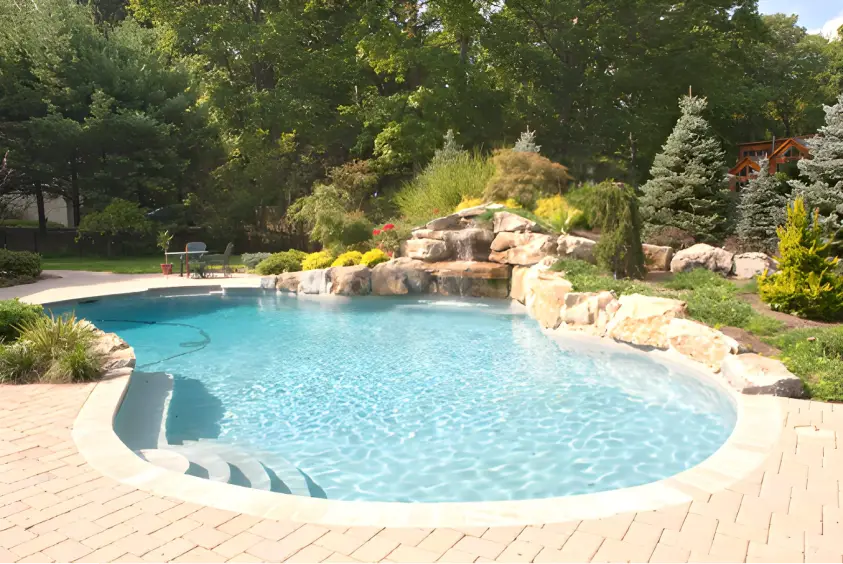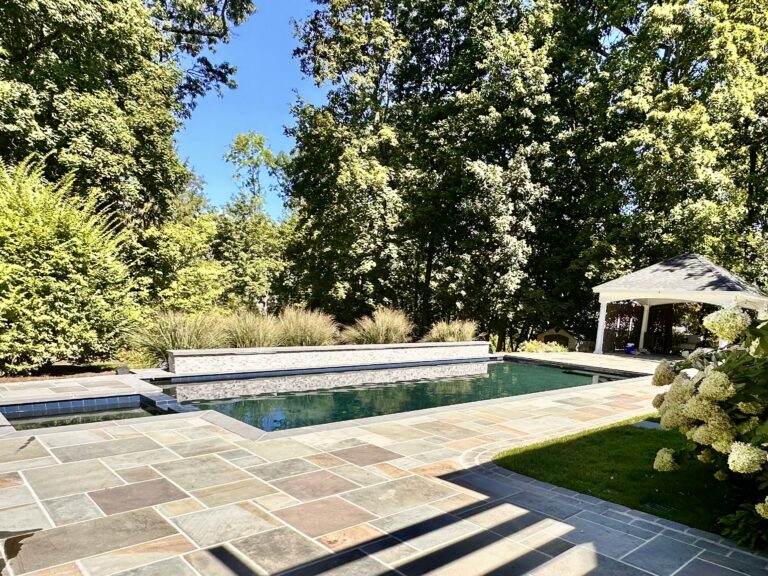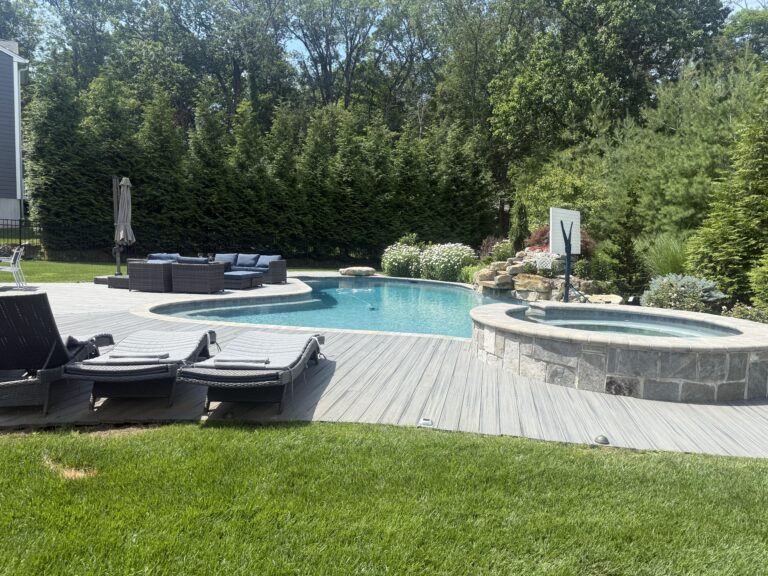Designing Your Concrete Dream Pool: Inspiration Guide For New Jersey Homeowners
Create your dream concrete pool in New Jersey with unlimited design possibilities, from unique shapes to built-in features. Though requiring a higher investment ($50,000-$120,000), these pools last a lifetime with proper maintenance—outperforming vinyl and fiberglass alternatives in durability and customization potential.
Key Takeaways
- Concrete pools offer unlimited design possibilities and can be customized with features like unique shapes, built-in benches, and water features that other pool types cannot accommodate.
- While concrete pools cost more upfront ($50,000-$120,000) and require more maintenance, they can last a lifetime with proper care, making them a long-term investment.
- New Jersey homeowners should carefully consider pool placement factors including drainage, property setbacks, seasonal sun patterns, and freeze/thaw cycles unique to the region.
- Selecting the right pool decking material is crucial not only for aesthetics but also for practical considerations like heat retention and maintenance requirements.
A concrete pool transforms your New Jersey property into a personal resort that reflects your unique style while providing decades of enjoyment. Unlike prefabricated alternatives, concrete pools offer unlimited design possibilities that can turn even challenging landscapes into stunning outdoor living spaces.

Why Concrete Pools Reign Supreme in New Jersey
When it comes to creating your dream backyard oasis in New Jersey, concrete pools stand out as the premium choice for homeowners seeking durability, customization, and long-term value. The Garden State’s unique climate, with its distinct seasons and freeze/thaw cycles, demands pool construction that can withstand environmental challenges while providing decades of enjoyment.
Concrete pools offer unparalleled strength and longevity compared to other options. With proper maintenance, a well-constructed concrete pool can literally last a lifetime, becoming a permanent feature of your property that enhances both your lifestyle and home value. This durability is particularly valuable in New Jersey’s variable climate, where seasonal temperature fluctuations put significant stress on outdoor structures.
Sage Landscape Contractors and Tree Experts has seen firsthand how concrete pools stand the test of time in New Jersey’s challenging conditions, providing homeowners with decades of trouble-free enjoyment when properly designed and maintained.
The company’s experts explain that beyond durability, concrete pools provide virtually unlimited design possibilities. “Whether you envision a classic rectangular pool, a freeform lagoon-style retreat, or a modern geometric design, concrete can be formed into any shape imaginable,” they said. “This flexibility extends to depth variations, built-in features like tanning ledges, and integrated water elements that create a truly personalized aquatic environment.”
Strategic Pool Placement
Working with Drainage and Grading
Strategic pool placement begins with a thorough assessment of your property’s natural drainage patterns and grading. In New Jersey, where seasonal rainfall can be substantial and winter snow melt creates additional runoff, proper drainage is essential for pool longevity and landscape health.
A skilled pool designer will evaluate how water naturally moves across your property and how the pool’s placement might affect these patterns. In some cases, the pool installation can actually help resolve existing drainage issues through thoughtful regrading and drainage system integration.
The pool’s elevation relative to the surrounding landscape requires careful consideration. Ideally, the pool should be positioned so that surface water flows away from it, not toward it. This prevents landscape runoff from contaminating the pool water and reduces maintenance needs.
Navigating Property Limitations
Properties often come with limitations that affect pool placement. Local zoning ordinances typically establish setback requirements—minimum distances between your pool and property lines, structures, utilities, and sometimes environmentally sensitive areas.
Easements—areas of your property reserved for utility access or other purposes—must also be identified and avoided during pool planning. Building a pool within an easement can lead to serious legal complications and potential removal requirements.
An experienced pool contractor like Sage Landscape Contractors will help you navigate these restrictions while maximizing your available space, often finding creative solutions that transform limitations into design opportunities.
Accounting for Seasonal Sun Patterns
Ideal pool placement maximizes sun exposure during the swimming season while considering shade patterns from nearby structures and vegetation. Strategic positioning can extend your swimming season by capitalizing on solar warming while avoiding excessive shading that cools the water prematurely.
A south-facing pool orientation often provides optimal sun exposure throughout the swimming season. However, some afternoon shade can be beneficial during July and August when temperatures peak, helping to prevent the water from becoming uncomfortably warm and reducing evaporation and chemical loss.
Creating an Integrated Backyard Experience
Your pool should function as part of a cohesive outdoor living environment, not as an isolated feature. Consider how the pool will relate to your home, existing landscape features, and other outdoor living areas.
Effective pool placement creates natural flow between indoor and outdoor spaces, establishing logical connections between the pool, patio areas, outdoor kitchens, fire features, and landscaped areas. This integrated approach maximizes functionality while creating a unified aesthetic that enhances your property’s overall appeal.
Designing Your Dream Concrete Pool
Custom Shapes and Unique Features
The design flexibility of concrete pools allows for virtually any shape imaginable—from classic rectangles to freeform naturalistic designs that mimic ponds or lagoons. This means your pool can perfectly complement your home’s architectural style and your property’s unique characteristics.
Popular custom features include beach entries (zero-depth entries that gradually slope into the water), infinity edges that create the illusion of water extending to the horizon, and swim-up bars that integrate entertaining spaces directly into the pool environment. With concrete construction, these elements can be seamlessly incorporated into your pool’s design rather than appearing as afterthought additions.
Depth Options for Multiple Uses
One significant advantage of concrete pools is the ability to create varying depths tailored to specific activities. Unlike fiberglass pools with predetermined shapes and depths, concrete pools can be designed with multiple depth zones to accommodate different users and activities.
Consider incorporating a shallow area (2-3 feet) for young children or for adults who want to relax in lounge chairs partially submerged in water. A moderate depth section (3-5 feet) works well for casual swimming and water games, while a deeper end (5-8 feet or more) can accommodate diving or more vigorous swimming.
Many homeowners are now opting for sports pools with consistent depths of 4-5 feet throughout, which are ideal for water volleyball, basketball, or exercise. Others prefer dramatic depth changes that clearly delineate different activity zones within the pool.
Built-in Amenities (Benches, Wading Areas)
Concrete pools allow for seamless integration of built-in amenities that enhance comfort and functionality. These features become part of the pool’s structure rather than additions, creating a cohesive design impossible with other pool types.
Popular built-in amenities include:
- Tanning ledges (shallow platforms where you can place lounge chairs in a few inches of water)
- Underwater benches for seating along the perimeter or in strategic conversation areas
- Swim-up bars that connect to outdoor kitchen or bar areas
- Beach entries that gradually slope from the deck into the water
- Integrated spa sections with hydrotherapy jets
Water Features That Wow
Water features transform a standard swimming pool into a multisensory experience, adding visual interest, soothing sounds, and movement that brings your pool to life. With concrete construction, water features can be fully integrated into the pool’s design rather than appearing as aftermarket additions.
Popular water features for concrete pools include:
- Sheer descents: Thin sheets of water that create a transparent curtain effect
- Rock waterfalls: Natural-looking cascades that blend with surrounding landscaping
- Scuppers: Architectural water spouts that create a controlled water flow
- Deck jets: Arcing streams of water that shoot from the pool deck into the pool
- Bubblers: Gentle fountains that rise from the pool floor in shallow areas
Beyond their aesthetic appeal, water features serve practical purposes. The sound of moving water creates a peaceful ambiance that masks road noise—particularly valuable in densely populated communities. Water movement also improves circulation, which can enhance water quality and chemical distribution.
Maintaining Your Concrete Pool Investment
Essential Care for New Jersey’s Climate
During the swimming season, concrete pools need consistent attention to water chemistry, filtration, and surface cleaning. The porous nature of concrete (even when plastered) means it can harbor algae more readily than fiberglass or vinyl pools, necessitating regular brushing of walls and floors to prevent colonization.
New Jersey’s distinct winter conditions require proper pool winterization to prevent freeze damage. This includes lowering the water level below skimmers, draining equipment, adding winterizing chemicals, and installing the appropriate pool cover. Proper winter care prevents costly structural damage and makes spring opening significantly easier.
Long-term maintenance includes periodic acid washing every 3-5 years to remove stubborn stains and mineral deposits that accumulate on the plaster surface. More significantly, concrete pools typically require replastering every 10-15 years, representing a substantial maintenance investment of $8,000-$10,000 depending on the finish selected and pool size.
Long-term Value: The Concrete Advantage
Despite higher initial costs and maintenance requirements, concrete pools deliver superior long-term value for New Jersey homeowners seeking a permanent aquatic retreat. Their unmatched durability, customization potential, and ability to be renewed through replastering means they can truly last a lifetime—something no other pool type can claim.
By partnering with experienced designers and contractors, you can create a concrete pool that provides decades of enjoyment while enhancing your property’s beauty, functionality, and value. Your concrete dream pool isn’t just a place to swim—it’s an investment in a lifestyle of outdoor enjoyment tailored specifically to your family’s needs and preferences.



